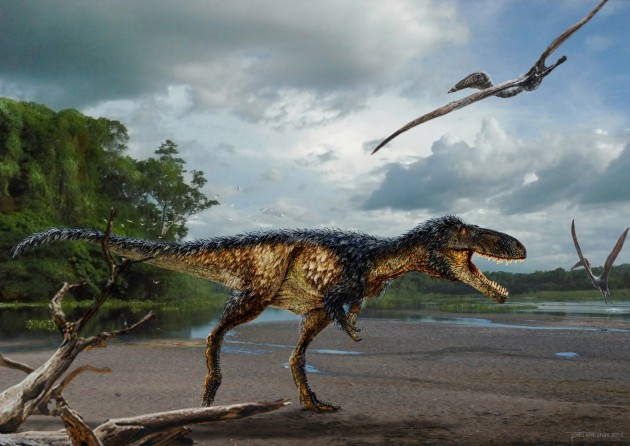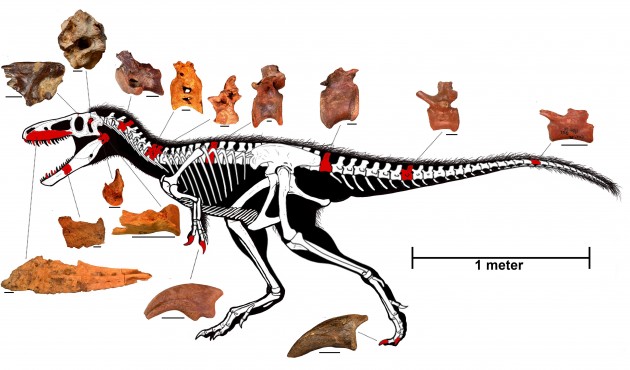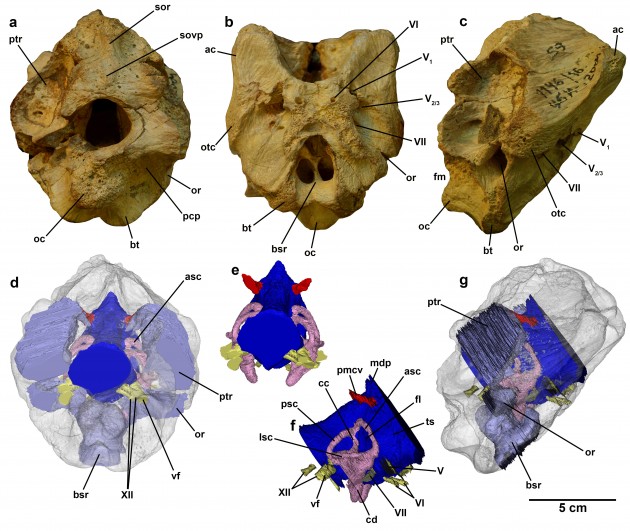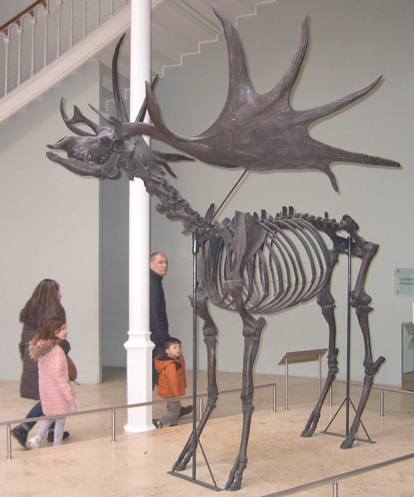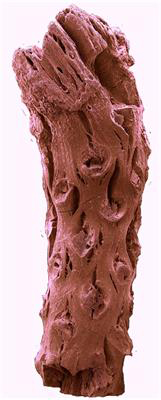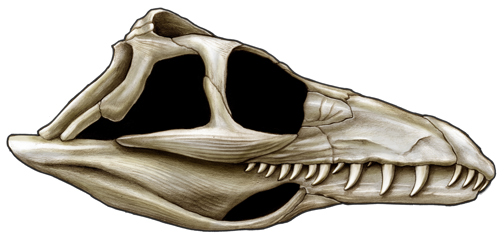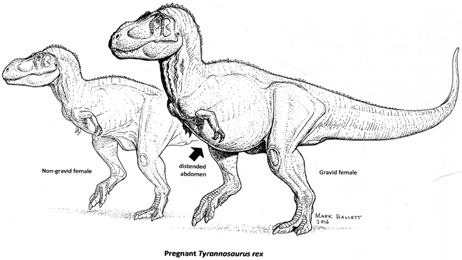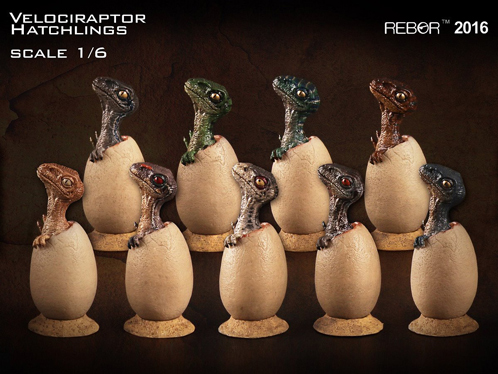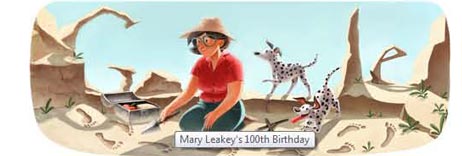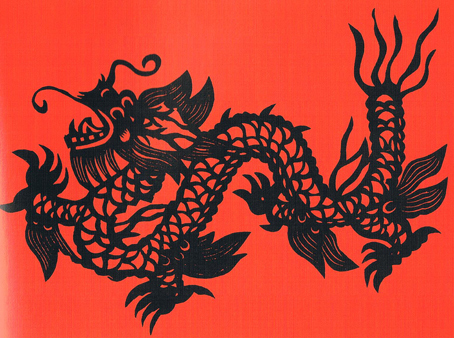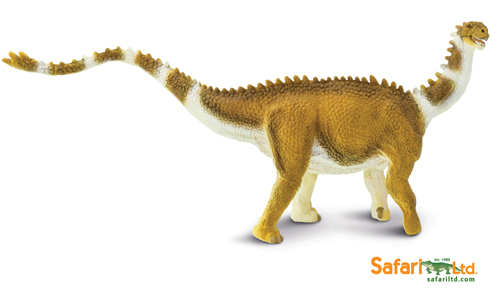Fossil Study Suggests how Tyrannosaurs Got Big
Timurlengia – Important Addition to the Tyrannosaur Family Tree
Timurlengia, or to give the newest member of the tyrannosaur family tree its full, binomial scientific name Timurlengia euotica (pronounced Tee-mur-leng-gear-ah oo-ot-tick-ah) has been introduced to the world. Lots of media coverage for this, the latest member of the tyrannosaur super-family, the Tyrannosauroidea and in this article, rather than go over old ground, we shall instead focus on some of the more significant aspects of this particular piece of fascinating research.
Tyrannosaur Fossil
Timurlengia Roaming a Late Cretaceous Flood Plain
Picture credit: Todd Marshall
The illustration of Timurlengia above, depicts this tyrannosaur as a light and agile animal, weight estimates vary (170 to 250 kilogrammes), but note also that this dinosaur has been given a shaggy coat. There is evidence to suggest that at least some tyrannosaurids may have been feathered, these days, depicting a feathery theropod is becoming the norm. Soaring overhead are two pterosaurs, the species is Azhdarcho longicollis and those white objects in the background that can be seen just below and just above the long tail of Timurlengia are primitive birds.
Uzbekistan might not spring to mind when asked to name a famous fossil-rich part of the world that represents life in the Late Cretaceous, but strata in the Kyzyl Kum Desert represent one of the few places in the world where an insight into life on our planet some ninety million years ago can be obtained.
The Significance of the Bissekty Formation
The fossil material, representing less than five percent of the entire skeleton, comes from exposed strata dating from the early Late Cretaceous. These rocks are part of the Bissekty Formation of the Kyzyl Kum Desert (Uzbekistan). The Formation dates from 90 to 85 million years ago, a number of vertebrate fossils including many different types of dinosaur have been found in these rocks. The sediments indicate a low-lying coastal environment that was crossed by a number of large and highly braided river channels. The Timurlengia fossil material is believed to date from approximately 90 million years ago (Turonian faunal stage of the Late Cretaceous).
The Fossil Material T. euotica
Picture credit: Proceedings of the National Academy of Sciences
The picture above shows the amount of fossil material collected, crucially the pieces of jaw and the isolated teeth are typical of a tyrannosaurid. Described as being “the size of a horse”, Timurlengia is very typical in terms of its build and its size with regards to Late Jurassic and Early/Middle to early Late Cretaceous tyrannosaurids. However, what has puzzled palaeontologists is this, throughout the majority of the long lineage of the tyrannosaurs these animals probably filled secondary predatory niches in food chains.
Despite their wide geographical distribution, it was only towards the end of the Cretaceous that these types of theropod dinosaur started to evolve into the myriad of apex predators we know today. Could Timurlengia provide evidence to support how and why the likes of Tyrannosaurus rex, became so huge and dominant?
Filling a Twenty Million Year Gap
Significantly, the rocks that contained the Timurlengia fossils have been dated to, what might have been a key point in tyrannosaurid evolution. These fossils come from a time just about ten million years or so before the tyrannosaurs began to evolve great size. Tyrannosaurus rex, that most famous of all dinosaurs, was something like thirty times heavier for example, studying the Timurlengia fossils could provide clues as to why after tens of millions of years of being relatively small, did these particular meat-eaters become super-sized.
The Authors of the Scientific Paper Plotted the Position of Timurlengia in the Tyrannosaur Family Tree
Picture credit: Proceedings of the National Academy of Sciences
The picture above shows a tyrannosaur family tree, the position of Timurlengia euotica is outlined in red. This dinosaur’s phylogenetic relationship with earlier and the later much larger tyrannosaurids is outlined, along with the location of fossil discoveries and a geological time scale.
Key to Tyrannosaur Fossil Locations
Red = Asia (including Uzbekistan)
Blue = Western North America (Laramidia)
Yellow = Eastern North America (Appalachia)
Pink = Europe
Studying the Braincase – Obtaining Information about Tyrannosaur Senses
The fossils used in the study were collected by Dr Hans Dieter Sues (Chair, Department of Palaeobiology, National Museum of Natural History, Smithsonian Institution ) and his colleague Alexander Averianov from the Russian Academy of Sciences over a ten year period. It was when the partial braincase was identified and analysed using a CT scanner that the link between this tyrannosaur and its more illustrious and later relatives became established.
CT Scans
The detailed CT scans revealed that although Timurlengia was not that big, about the size of other Cretaceous tyrannosaurids, it did possess a highly sophisticated brain and its inner ear was very reminiscent to the features of the inner ear found in Late Cretaceous tyrannosaur giants. This suggests that Timurlengia had very sharp senses including great hearing, particularly at low frequencies, could this have give this predator a competitive advantage?
The Partial Braincase (top) and the CT Scan Evidence (bottom)
Picture credit: Proceedings of the National Academy of Sciences
A Partial Braincase
The partial braincase was actually discovered back in 2004, but it has remained unexamined and in storage at the Zoological Institute of the Russian Academy of Sciences until palaeontologist Steve Brusatte (Edinburgh University) was given the chance to study the fossil. He realised the importance of this specimen, the CT scans showed that Timurlengia had long inner ear canals, ideal for hearing a range of sounds especially low frequency noises and this research has led to the subsequent paper being published in the Proceedings of the National Academy of Sciences.
The picture above shows three views of the partial braincase of Timurlengia euotica (posterior view, ventral view and right lateral view). The bottom row of images are composite pictures from the various CT scans. The brain is stained dark blue, the inner ear is pink, nerves highlighted in yellow and major blood vessels are coloured red. This study suggests that the tyrannosauroids apparently developed huge size rapidly during the latest Cretaceous, and their success in the top predator role may have been enabled by their brain and keen senses that first evolved at smaller body size.
Dr Sues commented:
“This fossil shows that tyrannosaurs developed their advanced head first. Timurlengia’s skull, though much smaller than that of T. rex, shows a sophisticated brain that would have led to keen eyesight, smell and hearing.”
The genus name honours the Asian warlord Timur (also known as Tamerlane), the trivial name means “well-eared” a direct reference to this dinosaur’s hearing capabilities.
Not the Entire Story
Having very well developed senses would have greatly assisted the tyrannosaurids, but this in itself does not explain how these theropods rose to dominance towards the end of the Mesozoic. There were, in all likelihood, a number of other factors involved. For example, bigger predatory dinosaurs would have had to have gone into decline and probably become extinct to permit the tyrannosaurids to exploit the vacuum left in the food chain.
The reason for the decline of other predators remains unclear. As far as we aware, despite the abundance of vertebrate fossil material associated with the Bissekty Formation, no very large theropod fossils have been found to date. If there was an apex predator or predators sharing this environment, then the identity of these dinosaurs remains unknown.
Carcharodontosauridae Decline
World-wide many of the apex dinosaur predators known to have existed around 100 to 90 million years ago are representatives of the Carcharodontosauridae. This family of theropods, which includes such iconic giants such as Acrocanthosaurus (United States), Sauroniops (Morocco) and Carcharodontosaurus (North Africa), did decline and did eventually become extinct, but studies have shown that these predators too, also possessed sophisticated senses. Perhaps the evolution of different types of prey triggered this “changing of the guard”, this in turn, could have been influenced by the rise of the angiosperms (flowering plants).
Tyrannosaurs may be iconic dinosaurs but there is much about their long history that we still do not understand. Timurlengia along with future fossil finds will help to shed more light on this palaeontological puzzle.
A Close up View of a Tooth Assigned to Timurlengia
Picture credit: James Di Loreto, Smithsonian Institution
Last month, Everything Dinosaur reported on a new study into the tyrannosaur family tree by Steve Brusatte and colleagues. This was a re-assessment of an earlier piece of research (2010), the phylogeny of tyrannosaurids being updated as a result of recent fossil finds.
To read this article: An Update on the Evolution of Tyrannosaurs.


